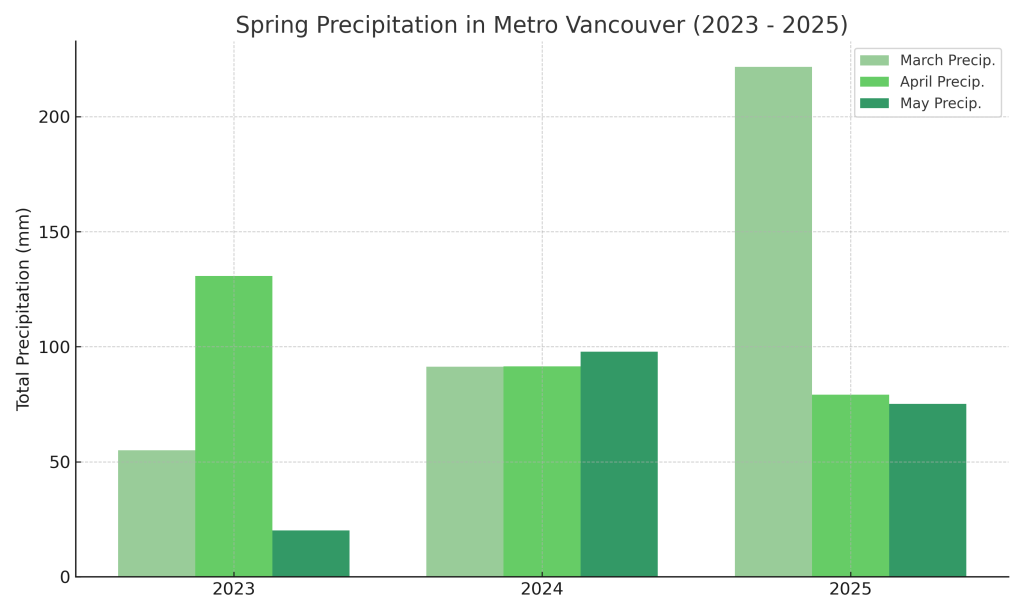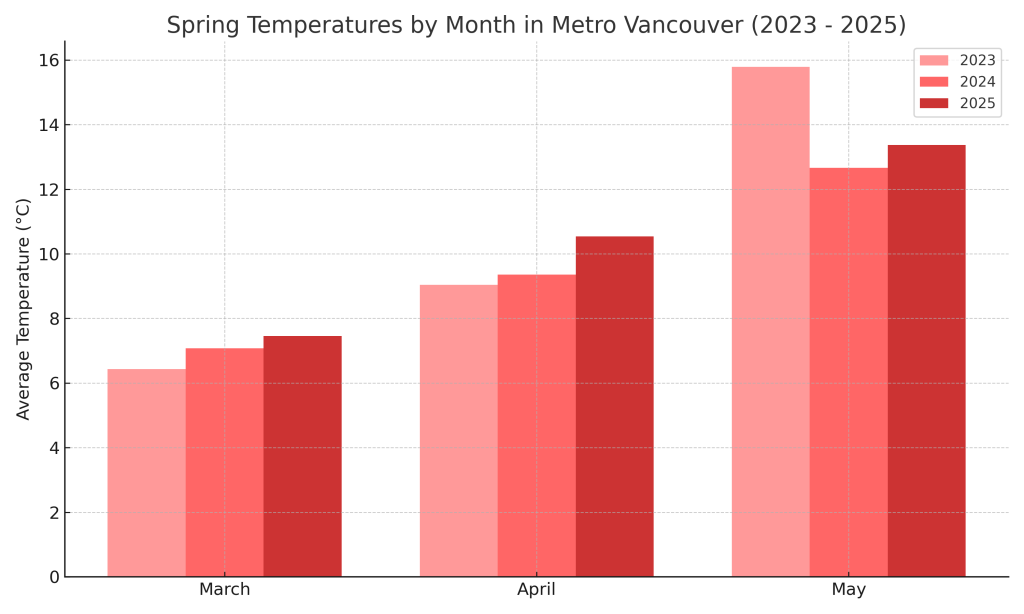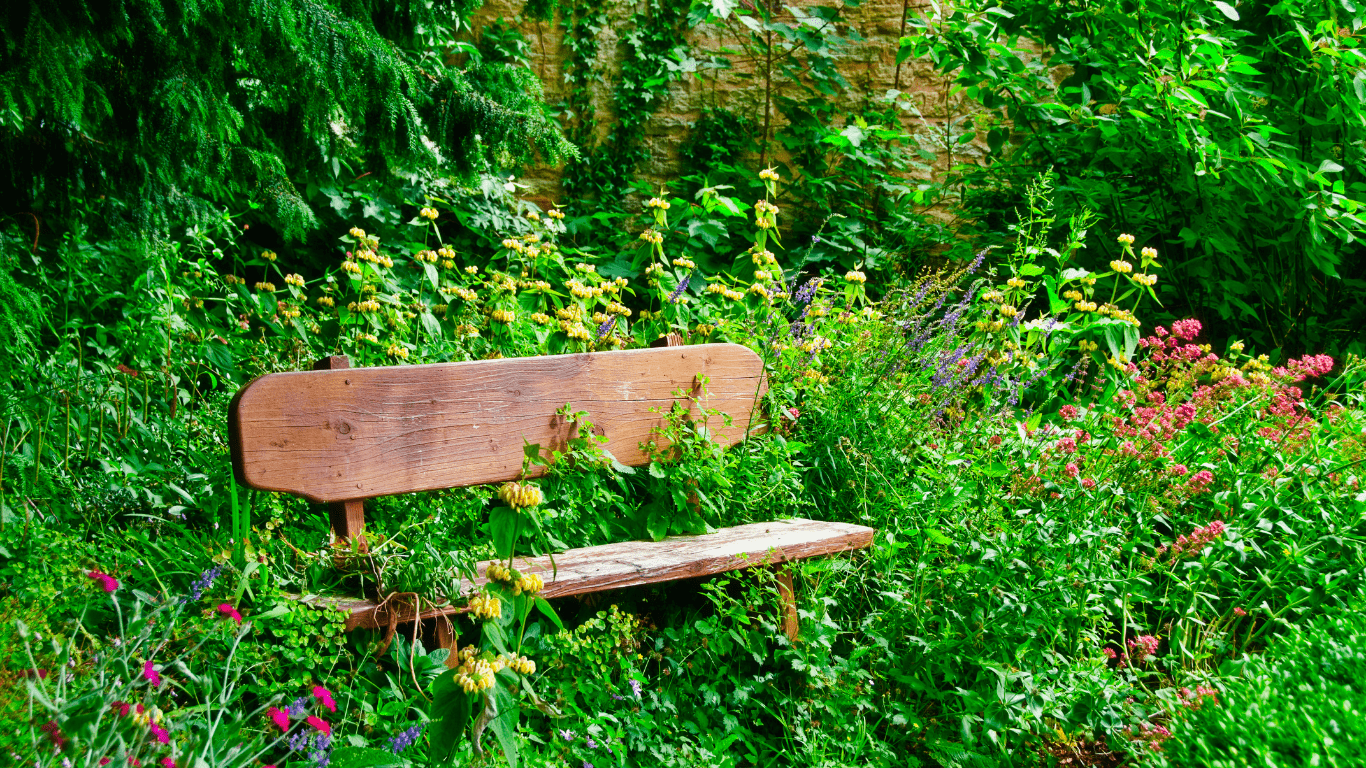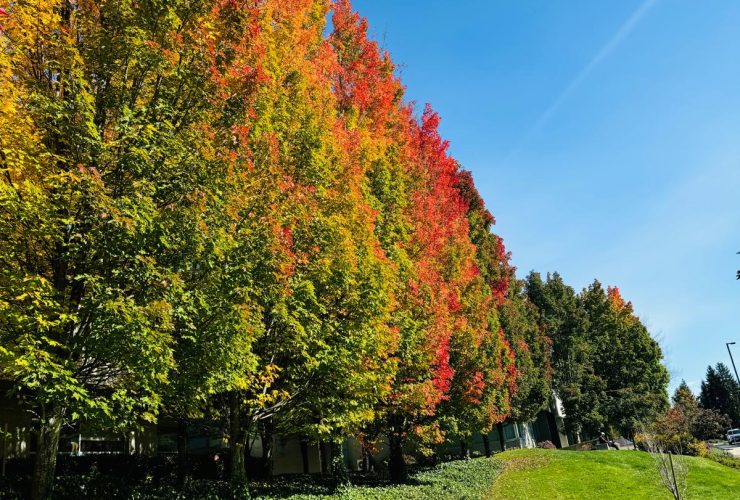Across Metro Vancouver, commercial and strata property managers and landscape teams are dealing with unusual plant growth in summer 2025. If you’re wondering, “Why are plants growing so fast this year?”—you’re not alone. A warm, wet spring created the perfect conditions for explosive early summer growth—weeks ahead of schedule.
A Spring Like No Other – The Cause of Unusual Plant Growth in Summer 2025
According to climate data from Environment and Climate Change Canada (ECCC) stations across the Metro Vancouver region 1, precipitation levels (rainfall and snowmelt combined) rose significantly in early 2025 compared to previous years. At the same time, average spring temperatures were noticeably higher.
The Data: 2025 Spring Was Wetter and Warmer
| Year | March Temp (°C) | March Precip. (mm) | April Temp (°C) | April Precip. (mm) | May Temp (°C) | May Precip. (mm) | Spring Total Precip. (mm) |
| 2023 | 6.43 | 55.02 | 9.04 | 130.69 | 15.79 | 20.09 | 205.80 |
| 2024 | 7.08 | 91.28 | 9.36 | 91.54 | 12.66 | 97.80 | 280.62 |
| 2025 | 7.45 | 221.68 | 10.54 | 79.09 | 13.37 | 75.14 | 375.91 |


Why Unusual Plant Growth in Summer 2025 Is Happening on Commercial and Strata Properties
In March 2025, Metro Vancouver saw over four times the precipitation of March 2023, and more than double that of 2024. This resulted in the overall spring precipitation increasing by approximately 82.7% compared to 2023 and 34.0% compared to 2024. At the same time, average spring temperatures continued to rise year over year.
The result? Moist soil and early root activation triggered rapid plant growth—weeks earlier than expected. These shifts are now disrupting regular early summer maintenance routines. Many properties were already overwhelmed. Lawns are growing faster than mowing schedules allow, weeds are outpacing monthly rotations, and shrubs trimmed in spring are overgrown again.
Proactive Property Maintenance Checklist for Managing Summer Plant Overgrowth
For many commercial and strata property managers, this rapid growth is leading to declining curb appeal, rising property maintenance costs, and growing pressure on landscaping crews to catch up. Here is a checklist to help property managers respond effectively and prevent the unusual plant growth in summer from escalating.
Control Overgrowth with Mid-Summer Shearing
Why this matters:
Overgrown hedges can block lighting, walkways, cameras, or building entries.
Shearing in mid-summer helps reduce the volume of future regrowth later in the season.
Dense plant mass limits airflow and increases the risk of mildew or fungal issues.
Best practice:
Use power hedge trimmers to shape and control broadleaf evergreen shrubs and hedges. Pay attention to plant species, as different types require distinct pruning techniques to maintain their best visual appeal and health.
Prioritize trimming near entrances, signage, and high-traffic areas.
Stay Ahead with 4-Week Weed Control Cycles
Many weeds thrive in warm, moist conditions, especially species like horsetail, bindweed, and creeping buttercup. Left unmanaged, they can dominate landscape beds within weeks.
Why this matters:
Weeds compete with ornamental plants for water, nutrients, and space.
They quickly overtake freshly mulched areas and groundcovers.
Fast-spreading weeds, especially like dandelions and bittercress seed, aggressively within four to six weeks.
Best practice:
Aim to remove weeds before they go to seed to maintain weed-free beds. Early and frequent weeding in spring can prevent infestations and keep beds up to 95% weed-free in theory.
Schedule consistent weeding every four weeks across all landscaped zones, staggered as needed based on site layout and weed pressure.
Use a combination of hand-pulling, hoeing, and targeted treatments for best results, especially along edges and hardscape transitions.
Increase frequency in problem areas if needed.
Recalibrate Irrigation Systems After Spring Rain
Why this matters:
Root systems that expanded during a wet spring still require consistent summer moisture.
Overwatering, especially from automated timers, can lead to fungal disease, root rot, and compaction.
Best practice:
Check and adjust timer zones, durations, and weather sensors.
Use drip irrigation or targeted spray heads in beds and hedges.
Audit the system for leaks, overspray, and inefficiencies, particularly on large commercial sites.
Schedule a Site Walk-Through Now
Late June through early July is the best time to review current site conditions and adjust service plans before growth becomes unmanageable.
Why this matters:
Some spring plantings may have failed.
Pests and fungal issues often emerge in early to mid-July.
Priorities are shifting from spring growth to summer maintenance and planning for fall.
Best practice:
Walk the site with your landscape provider before mid-July.
Identify which areas are falling behind, whether it’s overgrown shrubs, spreading weeds, or turf that needs closer mowing intervals.
Discuss adjustments to service frequency, pruning plans, and targeted treatments.
Develop a mid-season maintenance plan to stabilize growth and maintain a clean, professional appearance.
Start planning for rejuvenation on plants that have been overgrown for several years : this should be scheduled for early winter or early spring to restore plant health and size.
Consider Future Improvements
A mid-season walk-through is the perfect time to assess your site’s overall condition—not just plant health. During this review, you may want to:
- Replace aging wood structures or hardscape elements.
(Learn more: Allan Block vs Timber Retaining Walls: Which is Right for Your Property?) - Plan annual plantings for next year and select new plants for fall installation.
- Improve overall facility cleanliness to boost property value and reduce long-term operational costs.
(Learn more: 8 Ways Facility Cleaning Boosts Property Value and Reduces Costs)
Apply Summer Mulch to Suppress Weeds, Conserve Moisture, and Nourish Roots
Many sites were mulched in early spring, but heavy rain may have washed away or compacted the coverage, leaving soil exposed again.
Why this matters:
A fresh 2-3 inch layer of organic mulch conserves soil moisture, regulates temperature, and provides nutrients to plant roots.
Mulch blocks sunlight from reaching the soil, helping to suppress weeds.
The natural wood color of mulch adds curb appeal with a clean, consistent look.
Best practice:
Replenish mulch in prominent or high-traffic areas.
Look ahead with a multi-year mulching plan: refresh mulch in different areas each year and the whole site will be renewed within 3 to 4 years.
The Weather May Be Unpredictable—But Your Landscape Doesn’t Have to Be.
If your site is struggling to keep up this year, we’re here to help.
Get in touch today to schedule a landscape review or learn how Premier Landscaping helps commercial and strata sites stay ahead of BC’s unpredictable growing seasons.
Data Source:
Climate and precipitation data referenced in this article is sourced from the Monthly Climate Summaries published by ECCC. Our regional summary is based on climate data collected from stations across the Metro Vancouver area, within the approximate geographic range of:
Longitude: 122.271° W to 123.299° W
Latitude: 49.011°N to 49.488°N。
↩︎




